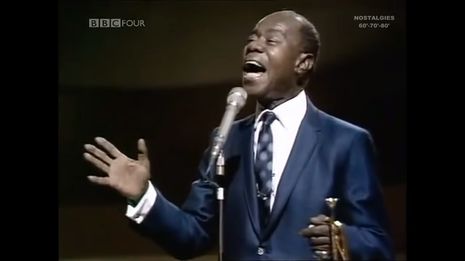A Love Letter to…Louis Armstrong
Juliet Firth contemplates the life and legacy of jazz musician Louis Armstrong

Nervously, I looked out upon my meagre audience seconds before stepping on stage, inevitably to be swallowed by the twelve pairs of eyes in the darkness before me. Weeks of preparing had led me to this moment in the Year 10 spring music concert and I was terrified. I trembled uncontrollably as I held my trumpet up to my face…but then I forgot my fears and remembered Louis.
With his bubbly charisma and impermeable confidence, Louis Armstrong was, and still is, such an inspiration to me. In that concert in Year 10, when I performed ‘What a Wonderful World’, such an important part of preparing was attempting to embody his musicality and character as a crutch for me to lean on and comfort me when the nerves hit. But, ever more poignant today, the world isn’t always a wonderful place. Louis was, and still is, able to harbour the positive force within his music that can transcend the challenging situations life throws at us. Far away from the smoky, segregated clubs where Louis first started out in Chicago, the same solace can still be found in that gravelly voice that is able to laugh right in the face of uncertainty, reassuring that everything is going to be okay.
"What we play is life."
Born in New Orleans in 1901, Armstrong grew up in poverty and made his first few musical appearances singing on street corners, often as part of a vocal quartet, for money to feed his family. He and others in the neighbourhood also had to scavenge for coal to sell. He was sent twice to the ‘Colored Waifs’ Home for boys’ (a juvenile detention centre), first at the age of nine, when he was discovered by police rummaging through a derelict house for scraps of metal, and secondly at the age of 11, for firing blanks from his stepfather’s pistol. The home was a decaying wreck of a house that treated its inhabitants poorly, often using corporal punishment. It was also where Louis received his first formal musical training, playing cornet in the home’s band.
Despite the poverty and prevalent segregation, New Orleans remained forever in Louis’ heart as not only his home but a place of unparalleled musical inspiration and influence. He reflected:
“Every time I close my eyes blowing that trumpet of mine, I look right into the heart of good old New Orleans. It has given me something to live for.”
Armstrong left education in fifth grade and started work as a gigging musician to support his family. He was soon noticed by prominent bands at the time; from then on, he rose quickly to fame and was dubbed “the World’s Greatest trumpet player” when he performed in Chicago in 1925. The Hot Five was the first jazz recording group he led, recording from around 1927. Within this group, he developed a truly unique and effortless improvisatory technique, playing lines that were characteristically similar to clarinet melodies in terms of their fast, rhythmic pace and fluid movement between ranges, which on trumpet is much harder to achieve. This imitation was noticed by New Orleans jazz rival and fellow classmate, Kid Rena, who said “he’s not playing cornet on that horn; he is imitating a clarinet”. Such imitation and sensitivity to timbre can also be heard in his early song ‘Potato Head Blues’ (written and recorded by Louis Armstrong and his Hot Seven in 1927) where the clarinet and trumpet (Louis) seem to merge seamlessly, like many voices in a crowded room.
It was in 1946 that Louis met the Queen of Jazz, Ella Fitzgerald. Little did they know then that this fateful encounter would lead to the coupling of one of the greatest jazz duos of all time. Ella and Louis’ feel-good hits, such as their cover of ‘Dream A Little Dream of Me’ (1950), effortlessly combine Ella’s unparalleled sensitivity for scat singing and Louis’ easy-going musicality, enriched by a profound friendship and mutual respect that was lifelong.
'Sweet dreams till sunbeams find you
Sweet dreams that leave all worries behind you
But in your dreams, whatever they be
Dream a little dream of me.'
One of their first collaborative albums, Ella and Louis (recorded 1956), is in my opinion nothing short of a masterpiece, with the Oscar Peterson quartet as watertight support. The album features many of Louis’ own songs, such as ‘April in Paris’ and ‘Cheek to Cheek’, alongside covers such as ‘They Can’t Take That Away From Me’, and ‘Tenderly’, all peppered with exquisite musical moments. Ella’s singing and Louis’ trumpet playing interact with such sensitivity that it’s as though we are listening in on a private conversation and only they know the joke.
"There seems such a sincerity in his tone"
What’s so great about Armstrong’s style is how full of integrity it is. The uniqueness of his expressive, rich vibrato is interchangeable between his singing and trumpet playing so that, no matter how he would perform, it is still the same character that shines through. There seems such a sincerity in his tone that is constantly accompanied with a chuckling commentary. His ‘What a Wonderful World’ (first recorded 1967) makes me want to laugh and cry at the same time, as it is so blissfully carefree and yet hauntingly self-aware. It would be wrong to try and guess what Louis was referring to by his lyrics, so I’ll leave you with his own words:
"Some of you young folks been saying to me, “Hey Pops, what you mean ‘What a wonderful world’? How about all them wars all over the place? You call them wonderful? And how about hunger and pollution? That aint so wonderful either.” Well how about listening to old Pops for a minute. Seems to me, it aint the world that’s so bad but what we’re doin’ to it. And all I’m saying is, see, what a wonderful world it would be if only we’d give it a chance. Love baby, love. That’s the secret, yeah. If lots more of us loved each other, we’d solve lots more problems.”– Louis Armstrong, spoken introduction to ‘What a Wonderful World’, 1970.
 News / Eight Cambridge researchers awarded €17m in ERC research grants27 December 2025
News / Eight Cambridge researchers awarded €17m in ERC research grants27 December 2025 News / Downing investigates ‘mysterious’ underground burial vault 29 December 2025
News / Downing investigates ‘mysterious’ underground burial vault 29 December 2025 Lifestyle / Ask Auntie Alice29 December 2025
Lifestyle / Ask Auntie Alice29 December 2025 Sport / Hard work, heartbreak and hope: international gymnast Maddie Marshall’s journey 29 December 2025
Sport / Hard work, heartbreak and hope: international gymnast Maddie Marshall’s journey 29 December 2025 News / News in Brief: carols, card games, and canine calamities28 December 2025
News / News in Brief: carols, card games, and canine calamities28 December 2025







